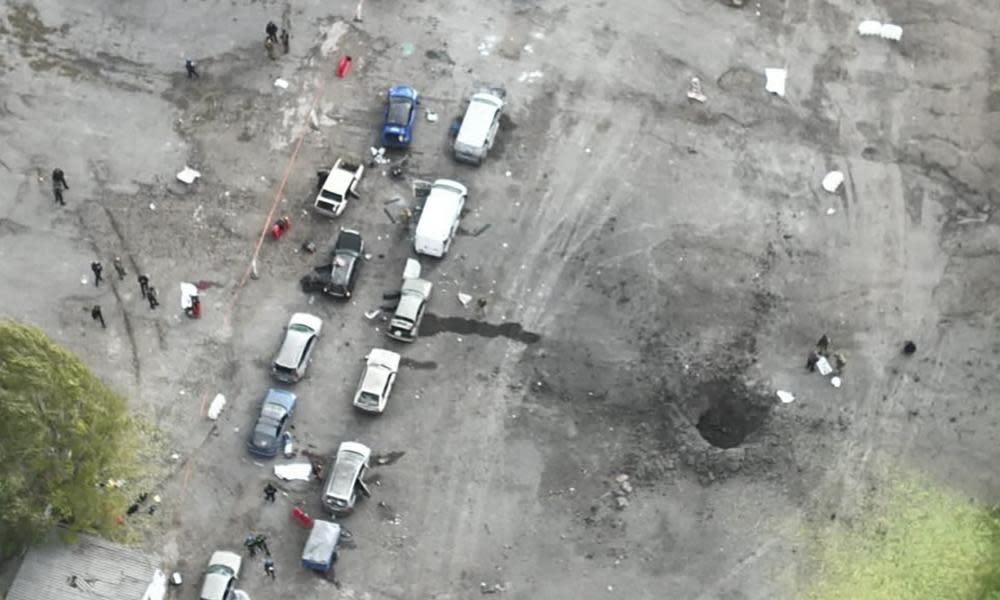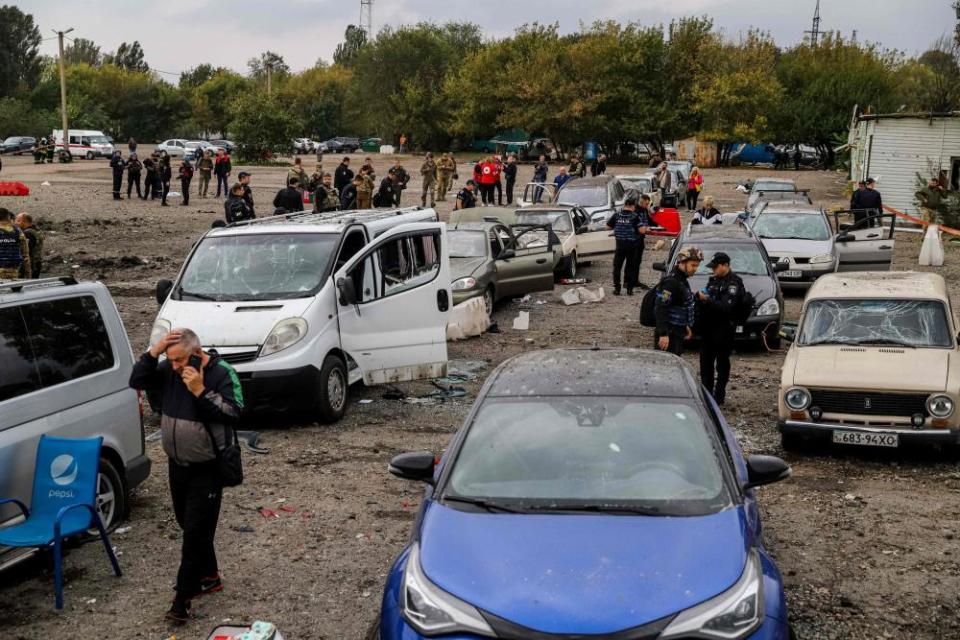‘There’s no doubt it’s a war crime’: horror of missile strike on Ukrainian convoy

In the dirt car park of a sprawling car parts market just outside the city of Zaporizhzhia, Ukraine, the bodies told horrific stories of the moment a Russian missile struck a civilian convoy, killing 25 and injuring scores more.
A man in late middle age was slumped inside his car, one hand holding the steering wheel. Not far away, partially covered in a sheet, another person appeared to be kneeling, collapsed next to the wheelie case they had been pulling.
Two women, limbs broken and twisted, lay where it appeared they had been talking next to a car in a queue of shattered vehicles that had been waiting to form into a convoy that – in a grim irony – would have taken them into Russian-occupied territory to the south, approved to enter by Russian forces.
While some had died instantly, others had managed to escape their cars and stagger a few brief steps before succumbing. Police and soldiers zipped the bodies of the dead into black bags and searched through wallets and handbags to find identification.
At 7.15am on Friday, dozens of cars had gathered to wait for a routine convoy to set off for the Russian-occupied territory that begins 12 miles away. About 150 cars are allowed each day by the Russians to make the journey south heading for cities such as Mariupol and Melitopol.

The cars and minivans were full of items to bring to families still in the south – bedding and children’s toys, clothes and even food. Some travellers would have hoped to pick up relatives to bring them back to Ukrainian-controlled territory amid fears that Russia’s annexation of four regions in Ukraine will leave many trapped.
At that moment, a Russian S-300 missile ploughed into the ground 10 metres from the cars as they waited for an escort for their journey. The blast tore through metal, shattered windscreens and blew out the windows of food kiosks and shops over a wide distance.

Volodymyr Marchuk, a spokesperson for the local governor’s office, told the Guardian what had happened. “[The car parts market] is a logistic hub to allow people go into the temporarily Russian-occupied territories. The Russians only accept 150 cars a day so that’s why we created a programme where people could go there to register and get their number in the line.
“At 7.15 this morning there were a large number of cars waiting for their turn to cross, mostly people who want to go to and drop off aid to relatives. Maybe pick up people who want to leave on the way back.
“That was the queue they hit with an S-300 missile. There’s no doubt it is a deliberate war crime. They always say they are aiming at a military object and hit something else. But there are no military objects near that site. That’s why there’s no doubt that it’s a terrorist act.”
With scores of injured removed to local hospitals, emergency workers carried on with the grim task of identification and removal of bodies.
Standing on the road nearby, Dalina Yakushava, 48, had arrived after the explosion to see if she could confirm her place in a convoy.
“This is where people are told to come and register by the authorities to join a convoy. You register online but I came to make sure my permission had been received,” she said. “I live in Mariupol. We just drove our daughter to Poland but we need to go back because my parents are there. It’s terrible but it is our home. There were a lot of cars waiting to leave this morning because no one has been able to go into the occupied areas for the past week.”
On Friday, the traffic was in both directions. A short drive away along the same road towards the Russian lines, hundreds of cars queued near a Ukrainian checkpoint waiting for an escort, their occupants relieved to be crossing over.

At the front of the queue, Nadya Nekustorova was playing with her 11-month-old daughter, Maria, as her husband, Dymytro, watched.
“We’re coming from Melitopol,” Nadya said. “We won’t go back until it is back under Ukrainian control. My parents are staying, which is a worry, but we wanted to leave because the Russians have said they will close the crossing to men from 1 October. We realised this might be our final chance. The Russians came to ask us if we were voting in the [sham] referendum. We said no so it seemed like we should leave.”
“It was a joke,” said Dymytro. “They were all just voting for themselves. The voting paper was a piece of copied A4. There were no seals or numbers to identify the vote was genuine. It was all fake. My brother has rented a flat in Zaporizhzhia so we’ll stay with him.”
Further down the line of cars, Alla Votovska, 68, and her son Viktor said they had waited for four days to come to the checkpoint from a village near the Zaporizhzhia nuclear power plant.
“Everyone is trying to leave,” said Viktor. “But they would only let a few cars leave from our village each day, so we had to keep coming back. Other people are trying to leave as well via the Crimea for Poland and Europe. Half of our village has left.”
Suddenly the cars were moving, heading for Zaporizhzhia on a road that would take them past the dead whose convoy had not been so lucky.

 Yahoo News
Yahoo News 
